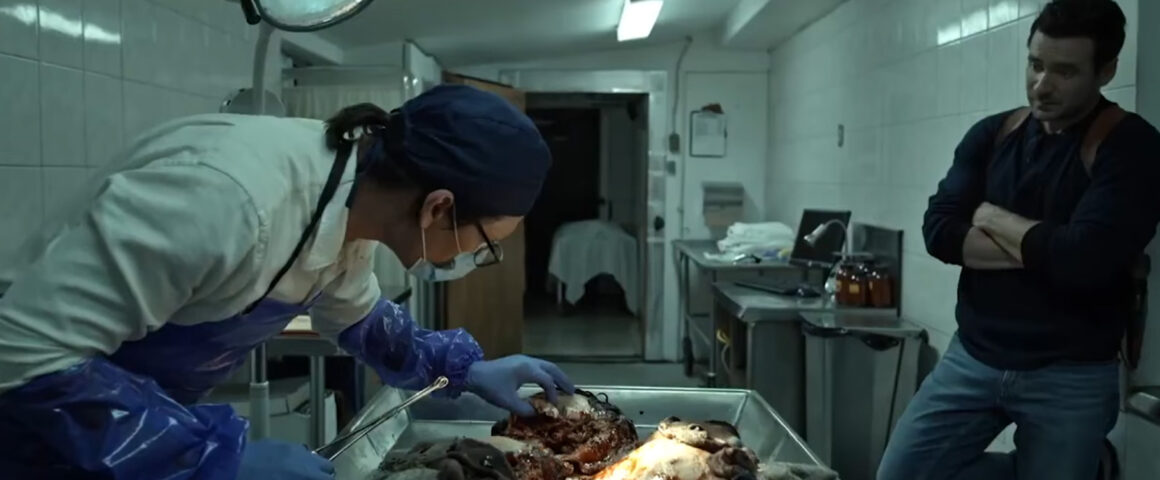Underground. Undertaken. Underpinned. Understated. Of these various under words, the one that tends to fit Canadian horror is “understated.” From the halcyon days of “Black Christmas” and the early work of David Cronenberg up to more recent fare including “Blood Quantum” and “Bloodthirsty,” Canada has produced much distinctive work in the genre, often benefiting from government subsidies and making a virtue of restricted budget and other resources. Filmmakers focus on atmosphere, character interaction and perhaps above all concept, exploiting simple ideas to create films that are unsettling and at times outright terrifying.
The Breach, directed by Rodrigo Gudiño (“The Last Will and Testament of Rosalind Leigh”) and written by Ian Weir and Craig Davidson (based on the Audible Original by Nick Cutter) is a Canadian curio that relies on understatement amongst its performers as well as some gorgeous scenery. We open on this scenery as a solitary canoe drifts down a river, surrounded by trees and a stunning sky. As the canoe floats past a family picnicking by the river, we gather from their reactions that there is something unpleasant in that canoe, before the title of the film fills the frame and we launch into a title sequence that takes us through mysterious clouds and lights. These credits are reminiscent of the opening of “Event Horizon” as well as the end of “Wounds,” and that will not be the last recall that Gudiño’s film provides.
Once the object in the canoe is inspected by police chief John Hawkins (Allan Hawco, “Midnight at the Paradise”), the mystery deepens and John sets off to investigate further with his ex-girlfriend Meg Fullbright (Emily Alatalo, “Spare Parts”), who knows the river and forest and hires out boats, and her ex-boyfriend Jacob Redgrave (Wesley French, “Trouble in the Garden”), who is also the local coroner. Thus, the tensions between our central three characters are established, and the film mechanically reminds us of these tensions periodically. This is but the first of a number of unnecessary details in the film that demonstrate overwriting, detracting from the central premise that is itself overly complicated.
Our heroes find a grand old mansion in the woods, which initially seems to be isolated yet also remarkably well-equipped. They understandably ask, “Who builds a place like this in the woods?” and no answer is provided by the film other than “We want to make a scary house movie and cabin in the woods was too clichéd.” Clichés are fine when used well, as both “The Cabin in the Woods” and 2013’s “Evil Dead” demonstrate. However, when the attempts to avoid clichés mean recourse to others, it leads to a deeply unsatisfying experience. The mansion is described as older than it should be, but we do not learn why. The power systems of the house have been repurposed, but we do not understand how. A further family dynamic featuring Linda Parsons (Natalie Brown, “Blood Honey”) is introduced that includes undefined drama and such pet names as Tinkerbell. This family seem to have wandered in from another film, suggesting a lack of faith in the central three. Granted, they are quite dull, the performances perfunctory at best.
Also perfunctory is the over-plotting to explain a rogue scientific experiment — aren’t they all? — which recalls “From Beyond” as well as “The Mist” and even “REC,” but brings none of the atmosphere, menace or drama of any of these. There are some very gory moments with some admittedly creative designs, but the inclusion of gore seems more like compensation for a lack of commitment to the other aspects of the film. Gudiño’s direction is often flat and clumsy, such as fast cuts when John, Meg and Jake discover things that we know are weird because they repeatedly say, “No fucking way.” Worse are the rather feeble action sequences that feature little visual flair and indeed contradict earlier instances. Further contradictions emerge when the isolated aspect of the mansion is removed for reasons best described as plot; suggestions are made of a global conspiracy that is supported by discussion of peanut butter (seriously); the juxtaposition of both scientific and occult tropes adds to the irritating hodgepodge that the film increasingly collapses into.
The Breach is a victim of an affliction found in many horror films, as well as action and, perhaps to a lesser extent, science fiction. When you look at some of the most effective horror films, from “Shivers” to “The Shining” to “Hellraiser” to “Ringu,” as well as modern efforts like “It Follows” and “The Babadook,” they are simple stories creatively told. The Breach, however, is a convoluted assemblage of stories, tropes and clichés, jumbled together with little focus or clarity. We do not get drawn into the character dynamics nor indeed the (admittedly dangerous) situation, because the film expends too much effort on introducing new weird or gruesome things to maintain attention. The end result is an unengaging mess that recalls enough better films that you may well wish you are watching those instead. The unwieldy collection of different elements overwhelm each other, but the viewer is left thoroughly underwhelmed.



